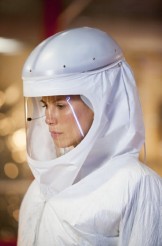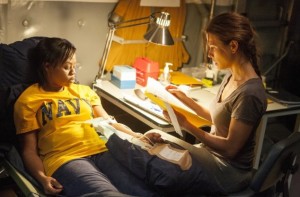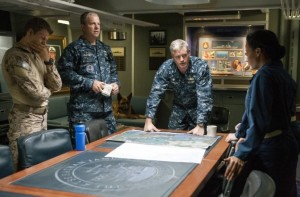In TNT’s THE LAST SHIP, in its first season Sundays at 9 PM and already renewed for a second season, the U.S.S. Nathan James is far from home base when a worldwide pandemic wipes out eighty percent of the planet’s human population. Commander Tom Chandler (Eric Dane) and his crew, plus a scientific team headed up by Dr. Rachel Scott (Rhona Mitra), are trying to find a cure while evading infection and hostile forces.
THE LAST SHIP, based loosely on a novel by William Brinkley, comes from executive producer Michael Bay, who even directed parts of the pilot. Show runner Steven Kane is another executive producer on the series. At a party thrown by TNT for the Television Critics Association press tour, he talks about working on a fictional drama about the U.S. Navy and about working with the real U.S. Navy to get it produced.
AX: How would you describe THE LAST SHIP?
STEVEN KANE: It’s a during-apocalyptic U.S. Navy action/adventure show, and it’s a big action, exciting, dramatic story about survival at sea.
AX: What did you want to do first, a story about the U.S. Navy or a story about the apocalypse?
KANE: Well, you think about the worst-case scenarios, the what-ifs, and I was always so intrigued by life at sea, what happens to you in those situations. This opportunity came along at the right time, to do a show with the Navy, and the cooperation we’ve had from the U.S. Navy has been just amazing, because I think they feel that we’re showing them in the right light – we’re showing that their mission is to help people, and we take these really well-trained, really noble people who are also way out of their comfort zone and put them in this extreme situation and see how they react. And ultimately, they react the way that would make us all look up to them and say, “Gosh, if there’s anyone alive helping the world in the apocalypse, it’s the men and women of the U.S. Navy.”
AX: Did you and TNT president/head of entertainment Michael Wright co-create the show, or did you create it and bring it to him?
KANE: Michael Wright was the spearhead of the whole thing. He brought projects to me and my partner Hank Steinberg and to Michael Bay. We think this is a Michael Bay show for TNT, this is the kind of thing that should be on this network, and Michael Wright kind of put together the whole team, and then Hank Steinberg and I wrote the script. The rest is history.
AX: The series is nominally based on the book THE LAST SHIP by William Brinkley. Is the series so different from the book that asking how much of the book the series encompasses is not relevant?
KANE: At this point, it’s pretty much irrelevant. As much as we admire the book and were inspired by the book, what inspired us from the book was the circumstance of being on a Navy destroyer during the end of the world. But the book was a nuclear-powered destroyer, it was involved in a nuclear war and it was more about restarting society as if there’s no chance to save the world, so it’s just us. This is a change – this is a different world, this is a more wired and connected world, this is not the kind of thing where you really are alone until you know you’re alone. Also, there are no characters from the book that we actually brought to the show. We just took the concept as an inspiration and the name of the ship and admired what Brinkley brought out in the book. But we really just took it our own way, and then once we got into it as TV writers – it wasn’t like GAME OF THRONES, where you’re saying, “Oh, let’s use this book or that book.” It was, “All right, now we’ve got a show, what are we going to do with it?” So to look for parallels at this point might not be fruitful.
AX: Is the Navy your favorite branch of the military?
KANE: They are now. When I met these people in person – I’m talking from the lowest enlisted sailors to the admirals that I met, to a person, they’re just smart, dedicated, ambitious, they’re here to serve and they really take it seriously, and I think the crew of the show [saw and understood] that same respect, because what happened was, you film on the base every day, so every day, everything stops for the raising of the flag in the morning and everyone salutes and does “The Star-Spangled Banner,” and in the evening, the sun goes down, they do “Taps,” and the Navy and the film crew really started to bond, and I think the entire film crew got the sense of patriotism from the process as well, so yeah, a new appreciation we got for the Navy doing this show.
AX: Has anything changed since you’ve shot the pilot?
KANE: Well, we’ve shot a bunch of episodes, so a lot has changed. There are all these new characters as the season progressed, and each one brought something new and special that opened up the show for us in new ways, so we started really excited about writing for the cast we have, but then we started getting into other new characters and their interactions, so we created a real tapestry and a real family on the ship that makes it a really character-rich story, because there are two hundred and something souls on the ship, and each week, we kind of bring someone up and they have a different life. So it’s been delightful, it’s been great, and we’re learning much more about the Navy life every day, too, so there are things in the pilot that, had we known [what we know] today, we would have been more accurate even then. So we’re getting more and more ensconced in the world.
AX: Are there any main characters who we didn’t meet in the pilot?
KANE: Yes. Without giving too much away, their first stop they make is in Guantanamo Bay, Cuba, and they come across an American who survived there somehow. And he gets taken on the ship and he becomes an integral part of the show. The actor’s name is John Piper Ferguson. He plays a character named Tex. And he’s terrific, because he brings a new energy, because he’s not Navy. He’s a private contractor who was working at the prison in Guantanamo Bay, and they were in isolated areas, they were avoiding the plague. So we come across him, and he can give us insight into what happened while we were gone. And he can also be this layman’s look at the Navy and say, “Why do you guys eat dinner there and those guys eat dinner there? That’s weird.” He can sort of be our tour guide. And he can also speak frankly to the captain, whereas others have to obey certain protocols. So he’s a real fresh character we’ve introduced and he’s with us the whole season.
AX: Does the disease have any symptoms we haven’t seen yet?
KANE: Yes. There’s a little bit of neurological damage that can happen, so there is some violence. It’s not a zombie virus, but it definitely changes your behavior toward the end. But it’s a very, very virulent flu-like blood-borne hemorrhagic disease.
AX: Are there particular challenges in setting a show on a ship?
KANE: Well, certainly production-wise. We shoot on a real ship – it’s a working ship, we have to work around them, but the Navy was extremely, extremely helpful, providing us with support and staff and letting us really get into what they’re doing there. But in general, carrying equipment up and down ladders and into small spaces and just working around them was a big challenge, but it was an exciting challenge, and I think when people see [THE LAST SHIP], they’ll see that the reason it’s so good and so authentic is because it was on a real ship.
AX: Have there been any production difficulties that you have encountered that you haven’t expected?
KANE: I would say every problem we’ve encountered we’ve expected, because the show is really ambitious. It means shooting nine episodes in many ways out of sequence. You shoot certain scenes, and then you go to the ship and shoot for two weeks and shoot on a real ship, and then you come back to a stage and shoot on a stage, then you go to locations. So for example, we finished Episodes One, Two and Three and Five, but actually we [hadn’t] finished them, because we still [had] more to shoot on sets that [were still under construction]. We shot parts of Episodes Eight and Nine, even though we were shooting Episode One. So we’re shooting it almost like one large feature ten-hour movie. So that is a major production challenge. But we also expected it. So I would say it’s nothing unexpected – it’s just hugely different from your standard show where you have a pattern. My last drama [TNT’s THE CLOSER] was a police procedural, where we knew we’d be five days, four days, in our police station sets, and two or three days we’d be out on location in Los Angeles arresting people. Here, every day is an adventure; every day, there’s a big stunt or a big action sequence or a big set piece or lots of makeup or explosions or even just a dramatic scene that requires a lot of prep work. We have an amazing production design team that has built us the interior of the ship on our set. I walked onto that set and I had memories of the ship – I really felt I was on the ship.
AX: At the end of first season, is there any kind of punctuation mark? Is it a cliffhanger, is it some kind of conclusion, is it they’re in the same amount of trouble as they were in Episode Nine …?
KANE: I would say it’s a combination – it’s a conclusion and a catharsis for the season. I think it’s important in storytelling [that] an episode has a catharsis, even though it’s part of a bigger thing. The season has a catharsis, but it also traps you in its doomed entities and propels you forward to have many questions and opens up a new possibility for Season 2 for sure. New enemies, new challenges, new characters. So it’s hopefully going to leave you as intrigued as the end of the pilot does.
AX: Does what you have planned for Season 2 require a different production paradigm?
KANE: I would say no. I would also say that there is no production paradigm. So things are very fluid and very changeable, but also what makes the show unique is the ship and the Navy of it all. So I would say it would be surprising if you don’t see that going forward.
AX: What else would you like to say about THE LAST SHIP right now?
KANE: I think I can speak hopefully more eloquently about the relationship with the Navy. It’s really fascinating. Because the question has been asked [by others that implies], “Oh, are you censored by the Navy, or are you doing their bidding?” It’s neither of those. These guys aren’t heroes because they’re in the Navy but what I’ve come to appreciate about the Navy is, it’s really about service. It’s not just about national security, it’s not about what side of politics you are, whether you’re a hawk or a dove. It’s about people who are trained to be mission-oriented, to do the right thing. They were sending ships to the Philippines when we were filming because of the terrible hurricanes and typhoons and whatnot. They are the ambassadors of America to the world, and they’re great ambassadors.
So we’ve come to really respect them, but we’ve also come to find them to be great experts for us, so we rely on them to be our partners in terms of telling the story right, just like I was relying on the LAPD when I was working on THE CLOSER, for example. So it’s a great partnership, it’s a great relationship, and I think what’s really cool about being on the Navy base, every morning at eight AM, everyone stops. The flag goes up, they do the national anthem, they do Reveille. The crew members take off their caps, point towards the flags, while the enlisted Navy guys make a salute. And for two minutes, we just stand at attention and honor our country, and then we get back to work. And at sunset, the same thing happens at Taps, and you saw this amazing respect that the crew of the TV show had for the crew of the Navy ship. And also, vice-versa, because the crew of the show is highly trained, highly motivated individuals who all want to make a great product. So there’s this really great parallel and respect that [if it hadn’t been done] on a real Navy base, we wouldn’t have had that extra level. I paired up [actor] Charles Parnell with the real Master Chief on the U.S.S. Halsey and the U.S.S. Dewey; I had [actor] Travis Van Winkle talk to real Special Operations guys; Eric Dane talked to the captains of these ships; we had [Adam Baldwin who plays] the XO talk to the XO. We literally wanted to understand life on the ship. So I think that, aside from all the action/adventure and intrigue and thrills and excitement and popcorn of it all, I think you’re going to get insight into a world that we’re seeing it warts and all, but it’s a world we don’t always see.
I’m very proud of it, very excited by it, TNT has been an amazing partner – I worked for them for many years on THE CLOSER and I’ve always found them to be great partners, but on this project, they’ve given us nothing but complete support to really take a big swing and tell a big story that you don’t normally see on TV. So we’re thrilled.
LEAVE A COMMENT BELOW AND LET US KNOW WHAT YOU THINK!
Follow us on Twitter at ASSIGNMENT X
Like us on Facebook at ASSIGNMENTX
Article Source: Assignment X
Article:THE LAST SHIP co-creator Steven Kane survives the apocalypse
Related Posts:













